Gingseng planting: Farm the forest floor
This is my first forest farming post here on Steemit, what better way to get started than with ginseng! Planting season is upon us as plants begin to senesce for winter slumber ahead. In their natural wild state during this is the time of year, ginseng plants are dropping their berry clusters and begining to draw back underground. Unfortunately, this amazing wild medicinal is becoming very threatened in the wild. Over harvesting and irresponsible harvesting practices by those trying to make some extra cash have come close to wiping this precious planet out of the wild. In our area, for instance, it used to grow wild but you would be hard pressed to find anyone who knows what it looks like in the wild. I have spoken with just a few 'old timers' who remember the days when one could find ginseng wild. They too acknowledge why it is no longer found. While many herbal consumers prefer 'wild harvested' over 'cultivated' herbs many do not realize that this practice could possibly push some species to extinction in the wild. A happy medium of the two is becoming a small movement that we are honored to participate in called 'wild simulated' and 'forest grown' which are different in their respective production methods. Although we do both methods we try to steer more towards wild simulated but some energy over the years does go in on the back end, which I'll get into in further posts. Today I'm going to be showing you how to plan and plant for something in between. By 'farming' ginseng and other precious forest medicinals you are not only doing you part to help preserve these species but taking pressure off of the wild populations.
More and more herbal suppliers are seeking out 'forest grown' and 'wild simulated' species instead of 'wild harvested'. You can help these suppliers fill their demands in responsible manners by growing them yourself on wooded lots or by requesting these herbs to be verified grown/harvested responsibly. Mountain Rose Herbs is one supplier who is now actively seeking 'forest grown verified' which is a verfication program offered by PCO (Pennsylvania Certified Organic). Next year we are hoping to get this verification as well as organic certification for all our crops. You'll hear more on this at some point.
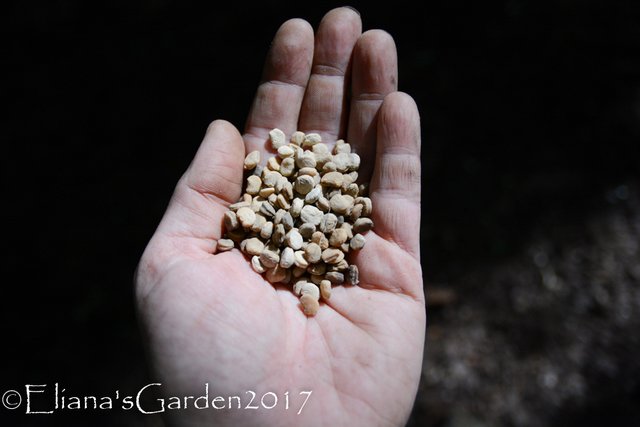
To begin with, when you purchase ginseng seed (or harvest seed) it needs to be stratified. Stratified means that it needs to go through a cold period to simulate winter in order for it to break dormancy. You can buy stratified seed or you can stratify it yourself. We are in our 3rd year of planting ginseng and have explored a few different suppliers of stratified seed. We have found one that we have been pleased with year after year and will continue to purchase from until are plants are providing our seeds.
As you enter the forest there are indicator species you can look for such as bloodroot and goldenseal that you can find good habitats near. If you don't have these species or don't know what you are looking at then take a gander at the forest floor and forest canopy. This is always the first thing we do when we are searching a new planting ground. Also take notice to which direction your planting site will be. Ginseng likes North-Northeast habitats, although we have successfully gotten beds started on west and south slopes.
The best time to plant is going to be in early to mid autumn, just as the leaves are beginning to fall but not all fallen. As you look at the forest floor notice the leaf types and the light speckling. Look for areas that have roughly 80% light, too much light and your plants will not be happy and total shade is not good either....just a little light coming in. Now look at the leaf litter...what types of leaves are you standing on/around. Poplar is your friend. The poplar leaves break down quickly and provide a lot of calcium for calcium hungry ginseng. If you find a good stand of poplar to plant in you will have to amend the soil very little if at all during the many years it takes for ginseng to be ready for harvest.
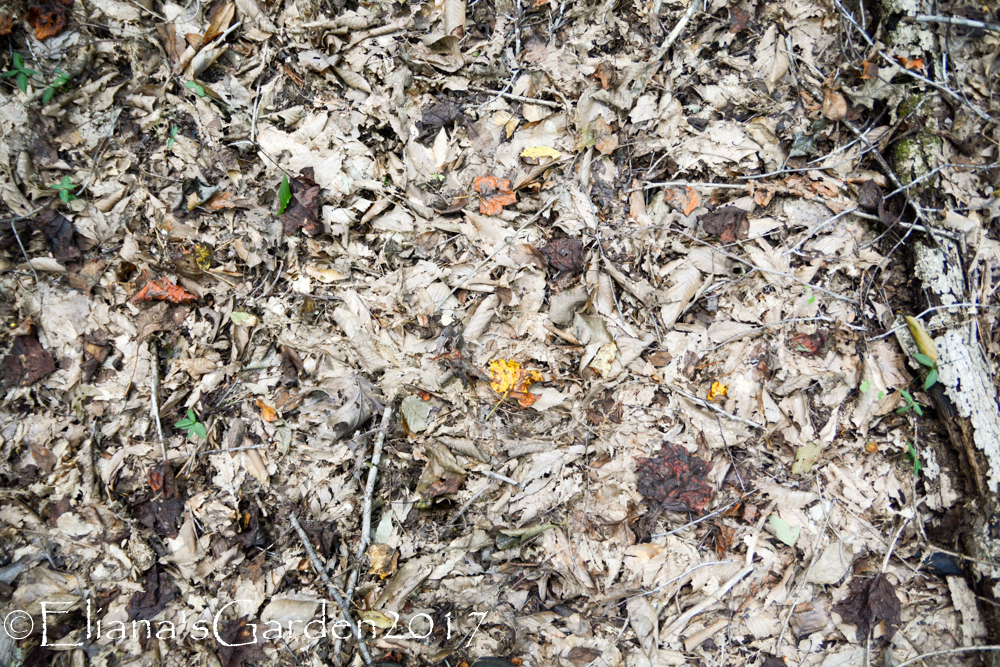
Forest floor
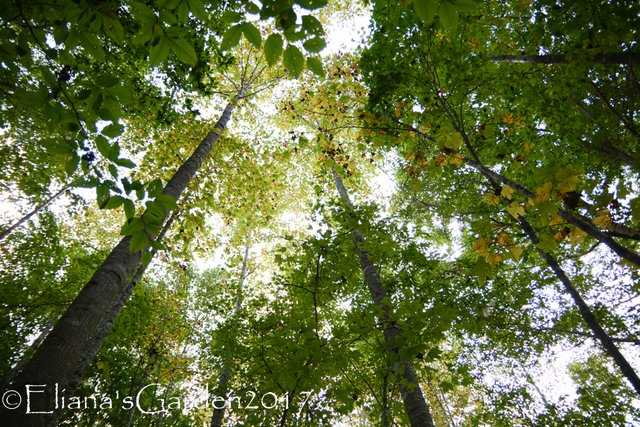
Forest canopy
Now look at the canopy. Does this back up what the forest floor says? Light? Trees? Poplar, beech, maple all break down pretty quickly and will not pack hard onto the baby plants as they are trying to emerge. Try to stay clear of oak if you can, it is high acid and leaves are dense taking a longer time to decompose.
Okay, so you've found your spot now. Any young trees or saplings need to come out? Cut them out if so, be mindful of how much light you are allowing in when you do. Don't mind the roots, they will decompose as well and add nutrients to the soil as they do.
As you clear your site from limbs, branches, twigs, small trees you may want to put them in a V shape just uphill of your area. This does two things for you: it is a indicator on where your patch is next year when you come back and it also can help direct runoff water around your bed to prevent your seeds/plants from washing away during a hard rain, especially if you are planting on a hard slope.

Upslope V
Next you want to pull back all the leaf litter and duff all the way to the forest soil. This takes a lot of raking but make sure you are exposing the soil. As you pull back the leaf littler take into consideration the fact that you are going to be pulling ALL this back on top of the planted area and probably much more from surrounding areas. We like to start towards the center and pull it all the way around the perimeter so it is easier to pull back in...some goes up, over, and down respectively. Don't rake it into the branch barrier either...it's a pain to get out.
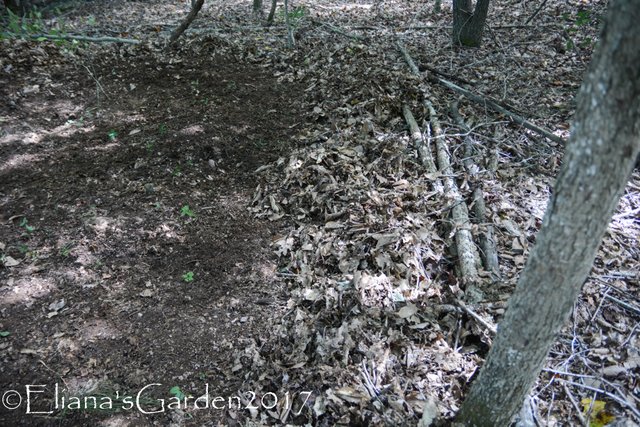
Next take a few minutes to pull weeds that may compete for growth space and nutrients. This doesn't have to be perfect but will help those little babies if there's not too much competition. Also remove any rocks at this point.
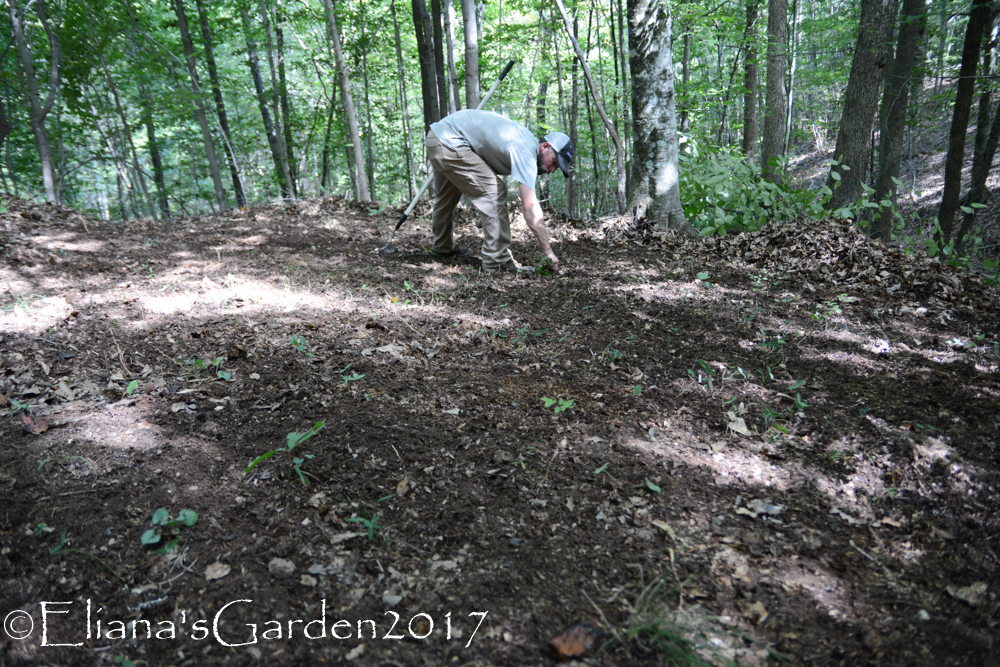
Now we typically will either slash a machete all over the place or rake good with a hard rake to loosen the soil a bit. In the past we have also experimented with skipping this step altogether, making rows, and even tilling. We find just loosening the soil with a hard rake is just fine for all intents and purpose and is much less labor intensive.
Now time for seeding. We like to slowly walk starting on opposite sides until we meet in the middle, lightly broadcasting as we go. You want to aim for roughly 5 seeds per square foot with the hopes that by the time it is time to harvest (at least 7 years out) you will have one healthy plant per square foot.
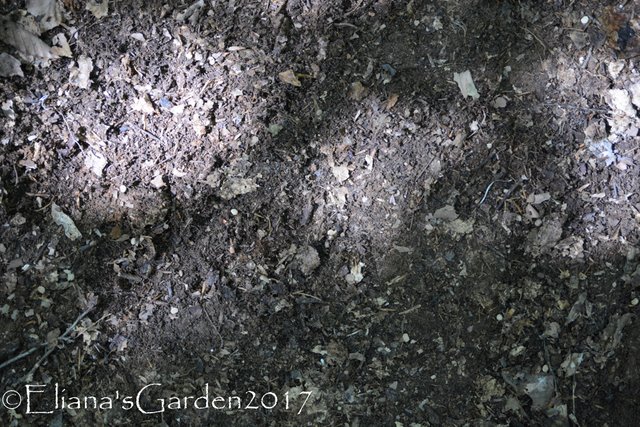
Now we like to do something we call the 'ginseng two-step stomp'. It feels kinda like you are line dancing as you slowly work your way across the patch stepping the seed hard into the ground. This is to make sure your seed has good ground contact and is less likely to wash away. Look closely at the picture below...you can actually see our footprints all over.
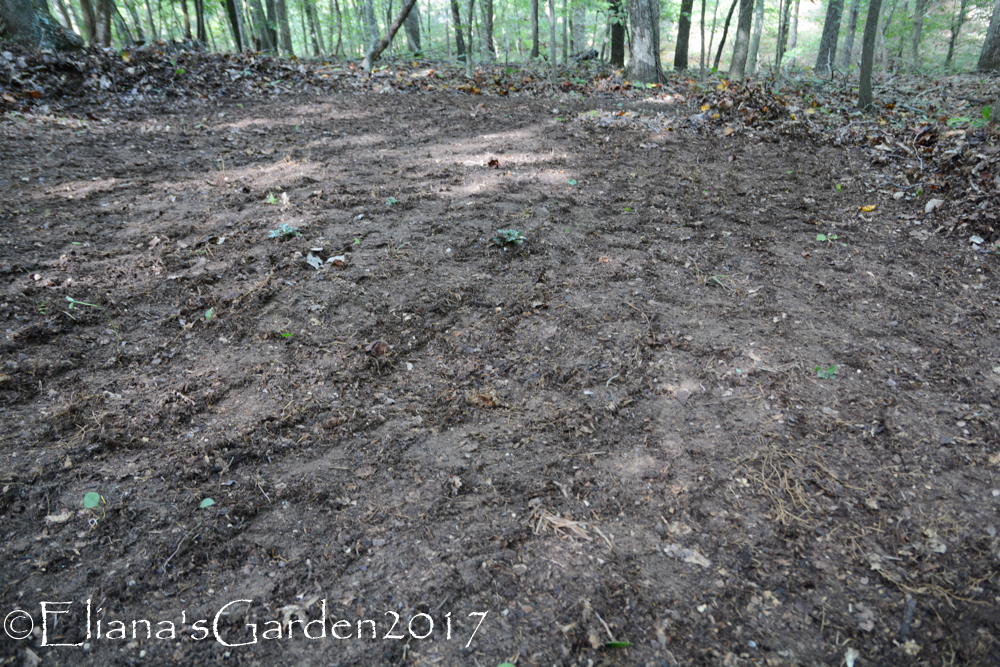
Now time to cover those babies up!! Rake all the leaves back onto the planting area. You will be dumbfounded how little leaves were returned when it felt like you took a ton off...it won't cover the same. You'll now want to go rake up leaves from surrounding areas and spread them on top of the seed bed to ensure good coverage. You'll want around 4 inches of leaf litter on top of them with more getting ready to fall from the canopy as autumn ensues.
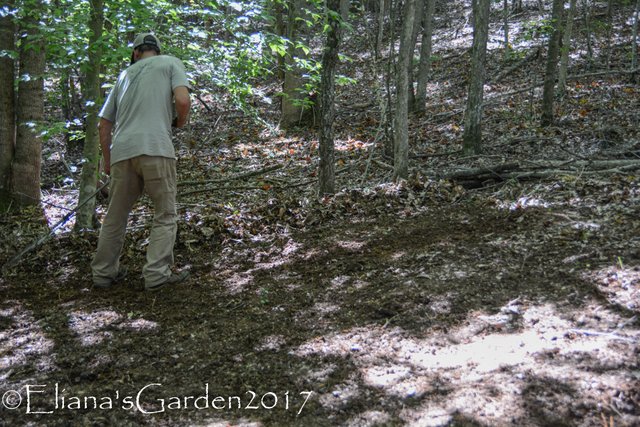
Okay, seed bed is well covered. You may want to take a gps coordinate or mark a tree so you remember it over the years (hopefully you'll plant more and more scattered around and need a way to remember them all with their planting year). Go home and make a record with good notes on when, how, etc in case you ever need it for sales permitting.
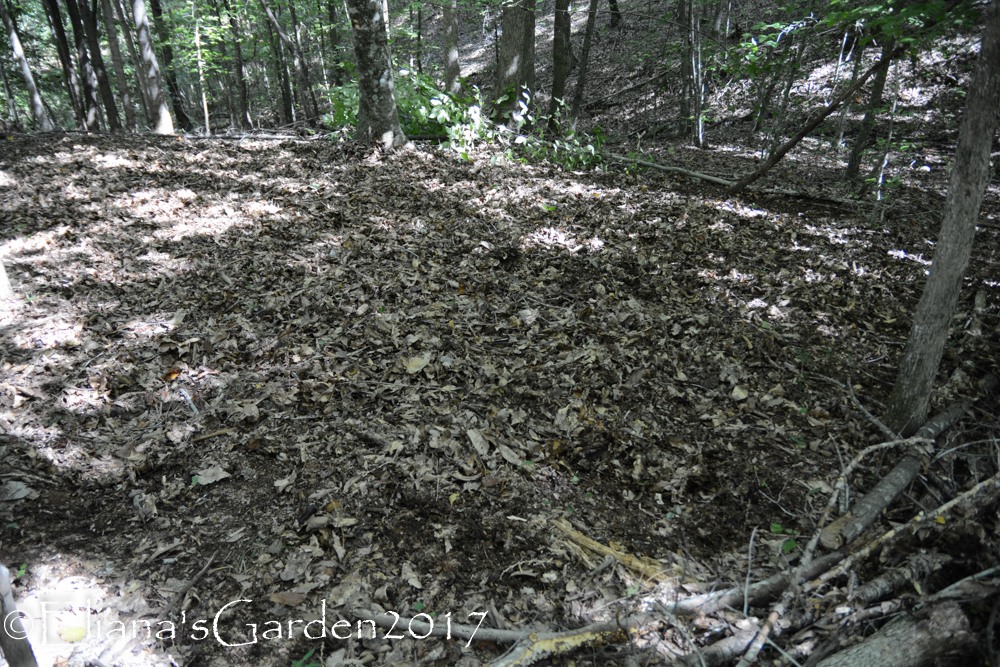
Side notes: We don't like to plant huge areas, no monocropping please. Large areas that only have this one species are going to be more susceptible to diseases, pests and poachers (just like any other crop). You can inter-crop goldenseal as a earlier harvest bonus that also has the potential to act as fungicide for the ginseng.
Happy planting friends!! Be responsible when encountering this precious, threatened species in the wild. Many of us will take off the leaves and plant the seeds so that they can buy another year of life hidden from poachers.
Closing thought: Be sure to follow us here on Steemit to catch a upcoming post about transplanting ginseng seedlings and maybe even an opportunity for plant swapping!!
Great work! Looking forward to seeing future process posts!
Thanks!! There's more in the making. :-)
Thanks. This is a species we don't really know about in Europe but I'msure it has huge potential.
Absolutely!!! I honestly can't speak knowledgeably into European efforts with ginseng but don't think it naturally grows there like it does here...HOWEVER, that doesn't mean that the habitat isn't available there and I would think there definitely would be a market for it.
It doesn't seem like it has much potential as an invasive.. I'm a bit paranoid about that aspect of swapping species between continents!
Oh no, there's regulations against that! Swap would be a USA thing only. Ginseng is heavily regulated between countries and there are tons of red tape in shipping plants between countries. However, if you think you may have a good habitat try to find someone closer to get a few seeds from. :-)
I'll stick that in the arquives at the back of my brain for future reference!! I'm busy trying to write up a thesis on wild food plants now.... it's all very abstract from the real world - computer work and red eye and statistics etc etc. Can't wait to reconnect again with wild foods after this stage is done. I loved the field work bit!
Oh but that sounds exciting too!! I'd love to read it when you're done if possible! I'm fascinated by wild foods. Where is your focus with it?
Oh my gosh, I have just found out that I have way longer to finish than what I thought. I had my dates all muddled up. I am so relieved!
I'm looking at the motivations that people have for collecting wild food plants, and I want to "segment" wild food foragers by their motivation, so describing the different types of foragers essentially. I'll be collecting data on people's feelings of connection to nature and on people's environmental attitudes...and hopefully some add on data about people's personal values... so essentially being able to discuss around how people use wild food foraging as a way to cultivate an active relationship with nature. There's all sorts of interesting theories within sociology to talk around it.
Honestly,am impressed with your quick growth as well as your contents,u obviously have great potential...keep it up,ur post is cool,d only thing missing is referencing your images...dats only if you took the images yourself...i will stop by more often...i upvoted and resteemed your post☺
Hi and thanks!! Yeah I'm surprised too! haha What do you mean by referencing my images? I have taken all the images on here so far and have my watermark on them so I'm a little confused. Do you mind clarifying for me? Thanks so much!
Omg!!....am really sorry dear...i just saw the watermark....this is a great post...once again am really sorry for the my comment earlier,was just trying to help..tnx
Oh no worries!! I was confused afterwards. haha Thanks for your helpful nature and trying to keep an eye out for us newbies. :)
As always, so good!! You really are bringing great quality to this platform. Wishing you great success!!
That's very kind of you, thanks so much! Wishing success to you too!
I am constantly amazed by how much you guys know about simply being alive. You astound me at times Stesha! ❤
Thanks Jon! Life isn't worth living if you aren't alive when living it. ;-)
Great post guys! I hope I am around in seven years to see the payout. ;P
That is very cool that you are doing it!
haha!! I hope I'm around too!!! lmao We are on our 3rd year planting ginseng so we will start selectively harvesting in probably 3 years. Hopefully steemit is still going strong at that point and I can share our process!
Do you have to worry about poachers or are you in a pretty secluded spot? I watched some of those ginseng shows and it seems like they were always worried about people coming in and stealing their sang.
I think anyone who grows high price items like this will have a natural worry of poachers, that's a reality of this type of 'farming'. However, trail cameras and seclusion help. We know other growers that have shot at poachers catching them in the act and that seemed to stop the action for a while (not killing them of course!). With the reality of it comes the risk. We probably make ourselves more vulnerable than others as we are the only ones in our community actively cultivating it AND trying to educate others on how to do it. Luckily not many people know what it looks like here and most of our planting grounds are NOT on our property (and quite secluded) so finding them would be quite difficult for anyone targeting us.
We think it's worth the risk to help the species, movement, and hopefully our kids college fund on the backend of it all. ;)
Heck yes! that is awesome. I wish you all the best. Grow sang grow!
This is another super interesting post -and on atopic I know zilch about. I really love how methodical you guys are about your various growing/harvesting efforts. That attention to detail is the big thing I sometimes feel is missing from novice foragers and content creators in general. Keep it up!
Thanks so much @dber! That's a great compliment. We are hoping be able to provide clear information with most of our posts as much as possible. The point is to encourage, inspire and educate...not confuse. haha Although I'm sure there will be posts that you'll read and go...'wtf are they talking about?' but we'll do our best to keep them to a minimum. I love reading yours too!
Besides the root can you use any other parts of the plant? How old does the plant need to be before you can collect seed from it? Just out of curiosity as I doubt it would grow in my part of the world! Lol!
Also do you think you'll dot some of the plants around in other areas of the forest when you transplant to try and get the wild population back up and hopefully give more chance that it will be missed by poachers?
Absolutely!! The leaves, stems, berries and root can all be used. The leaves actually have some beneficial constituents that are higher than the roots! I'll be harvesting leaves next year for tinctures, I'll definitely be doing a post about the process when I do. The berries make excellent juice (save the seeds though!)
Absolutely we plant for wild population too. Every year as we walking around the woods this time of year we will take 10+seeds with us and just pop them in nice little spots here and there. I'll start my transplant work next week and will be doing the same thing with them here and there. We try to put them in areas where we see their natural companion plants and of course ideal habitat. I also gift seeds and transplants to local friends who have similar desires to see the plant make a comeback. I'm actually considering doing something similar on here and offering a stock or seed swap with them...do you think something like that would go over well?
That's interesting on the leaves being higher than the root in some ways. It seems so much more sustainable to the plant to harvest the growing parts over the root. I wonder if a trend can be turned more towards that in the supplements market. 🤔 Looking forward to seeing how you make tincture. It's it a long process? Oh yes, of course save the seeds! Precious little life givers. 😁
I think offering stock and seed swaps would go over fantastically within the homesteading group. I know in the US some are already doing that. I believe it's part of our culture to swap and share! 😆
Mountain Rose Herbs is now buying leaves from some people I know. I'm hoping we can join within the next few years with that. Harvesting the areal parts of the plant is much much more sustainable but it is definitely different medicine than the root, as with most herbs. I'm just beginning to learn about the leaf medicine. I first heard about it earlier this year at a forestry seminar. Look into the Appalachian Beginning Forest Farmer Coalition if you are interested in getting started with growing woodland medicinals, great organization and resource for those of us in this movement.
I'll probably offer a swap within the next month!
I'm not sure if woodland plants is something I could grow here. I'm on an urban block anyway and in South Australia, so it probably wouldn't be anything like you would grow. Perhaps I should look into woodland plants for here though in case I do one day get somewhere I could do that sort of thing.
Oh i couldn't swap outside of the USA anyway. There are strict regulations surrounding that. :-/
Aussie imports are really tight anyway. No way they'd allow it. I was thinking more about researching native species here.
Do it! Do it! Do it!! I think every continent has plants that could use some assistance at the moment. Share what you find!
Wow, forest farming thrills me!
haha!! ME TOOO!!!
I was watching a show on the History Channel about people harvesting ginseng, and I caught myself wondering if this was a plausible idea. Great post! RESTEEMED!
Thank you!!! There is a growing movement to farm and thus protecting wild populations of these precious plants (and other forest medicinal and edible plants). I bet there is something that could be grown where you are too if you access to forest land!